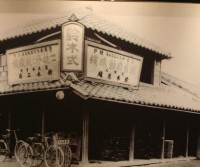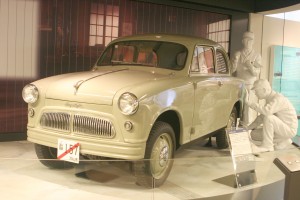Suzuki Michio

| Birth Place | Nezumino-mura, Nagakami-gun |
|---|---|
| Birth | 1887 |
| Death | 1982 |
Overview
Suzuki Michio was the founder of Suzuki Motor Corporation. He contributed to the advancement of looms and car manufacturing in Japan.
Biography
He was born as a second son of a farmer in a typical farm village with 32 houses in Nezumino-mura on February 18, 1887. His name came from Sugawara no Michizane, who was a great figure in Japanese history. He helped his parent pick cottons since the age around seven to eight and grew up listening to sound of weaving machine. As he was talented at crafting, he dreamed to be a contractor. Imamura Kōtarō hired as an apprentice with the contract of seven years. Under the strict boss, he concentrated on developing skills. Imamura had no choice but to take the floor loom crafting work, which was seen as a low class work, since there weren't many constructing works due to Japanese-Russo War. Naturally, Michio adopted its skills.
Electric power became steadily available thanks to the establishment of the electric power company in Hamamatsu in 1902. Eyeing on that there were high demands for looms, 21 year old Michio decided to work on loom manufacturing when his apprenticeship ended in 1908. The factory was built in Kaminitta, Kaminakajima, by remodeling and relocating the silkworm-raising house his family gave him. Japanese military placed him in the secondary reserve force due to his short height. Hence, he could commit to his work. After several days, he created a floor loom composed of wood and iron for his mother, Machi. This loom allowed her to weave ten times faster than the handloom she used before. The rumor spread out and he got many orders. This gave him confidence to establish Suzuki Loom Manufacturing (the precursor of SUZUKI MOTOR) in October, 1909.

He learned from the conversations with weavers that they needed the loom that could weave stripe patterns. In 1911, the Two-Shuttle Floor Loom that weaves cloths with stripe patterns was built. Next year, he earned the petty patent for the apparatus that moves the shuttle box up and down, which allows switching weft threads to make waffle patterns. Although unfortunately, the original of the device doesn't exist anymore, Suzuki Plaza displays the model of the loom built according to the patent documents and the loom housed in Hamamatsu City Museum. In 1912, he obtained his first patent with the warp let-off controlling device. The One-Shuttle Power Loom and the Four-Shuttle Power Loom Composed of Wood and Iron won the first prize at the exhibition held in Ashikaga in 1916. The demands of broad width fabrics were increasing this year.
The company reorganized as a kabushiki kaisha (joint stock company) in 1920. Suzuki patented the automatic threads winding control device for looms in 1923. The company faced the first labor dispute in Enshū area in 1926. The Sarong Loom introduced in 1930 made the world to aware the Suzuki brand as it was exported to many countries in Southeast Asia. The loom was revolutionary in the aspect that it used much lesser punched cards to weave waffle patterns since it employed the device that saves the cards. Suzuki earned petty patent for the device that sheds the middle warp edge threads in 1932. This device dramatically increased the productivity of weaving sarongs. However, the exports of the cloths rapidly shrank. It was caused by Japan's walk-out from the League of Nation as the result of its refusal of the demand from the organization to return Manchuria back to china in 1933.

He also worked on the development of automobiles. Although he succeeded on building a prototype, the war interrupted the research. The development carried out shortly after the war and another prototype was completed in 1954.Suzuki released a keicar, Suzulight in 1955.
He passed away in 1982.
The company renamed as Suzuki Motor Corporation in 1990.
Personality
In order to improve the quality of his products, he visited around his customer listening to their opinions and needs about his machines. "Always think from your customer's point of view. Provide whatever your customer needs. It's possible if you try hard enough."
The Sarong Loom was mostly purchased by small weaving mills with less than 20 looms. Suzuki sold the product by monthly installments, which was very rare at the time, so that even small business with little funds could buy.
When the others in the company opposed to undertake the automobile development, he motivated the workers by saying, "I can't think any reason not to do this. It is worth to take challenges especially when there is little money."